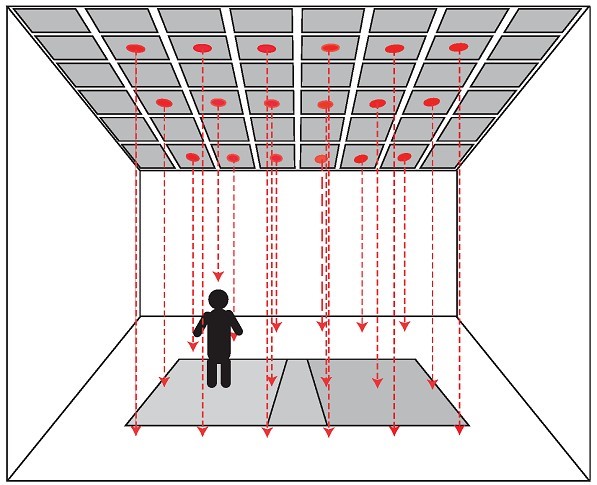A team of LESA faculty and graduate students from Rensselaer Polytechnic Institute and Boston University were recently awarded a US Patent titled, “Sensory Lighting System and Method for Characterizing an Illumination Space.” The patent describes how the LED lighting system in a space can detect occupants’ presence, location and pose without the use of cameras, thereby preserving the privacy of the room’s occupants.
“Every illuminated space has an optical “fingerprint,” said LESA Director Robert Karlicek, an inventor on the patent, as well as a professor in the Department of Electrical, Computer and Systems Engineering at Rensselaer. “If nothing is moving within the space, then the distributions of light and color in the space don’t move. Using a limited number of low cost sensors mounted on the ceiling, we can measure the optical fingerprint of any space and determine when and how things move within it.”
 |
|
Future smart ceiling panels, each mounted with a single-pixel depth sensor. The red spots represent the position where the ToF depth sensors are mounted, and the dashed lines indicate ToF signals.(LESA/LEDinside) |
The patented approach to privacy-preserving occupancy sensing uses technology called time-of-flight (ToF) sensing. ToF sensors—using light—return a reasonably accurate physical distance measurement, allowing one to map the space, and determine the location as well as height (sitting, standing, prone) of individuals and other objects in the room.
“Imagine a building management system in an environment such as a healthcare facility, office or retail space, warehouse, airport, or library that always knows where occupants are located as well as the kind of activity occurring, using information generated by the lighting system,” Karlicek said. “This kind of data is needed to maximize building energy efficiency, improve security operations, and automatically create more comfortable environments for occupants. The patented technology developed at LESA promises to be more cost effective and accurate than many competing technologies.”
Karlicek further noted that the privacy-preserving feature of the technology makes it very attractive for use in almost any setting, since cameras are not used and individuals cannot be recognized.
Perhaps most importantly, since most buildings already have lighting installed, the technology can piggy-back on existing infrastructure, once an LED lighting system is in place.
“Time-of-flight sensing is very appealing for occupancy sensing in smart environments and Internet-of-things applications, since it’s
fairly robust to the ambient light in the room and the clothing of the participants. The sensors are also becoming very inexpensive. We’re excited about integrating time-of-flight into more advanced cognitive environments that can understand and react to the activities of their occupants,” said computer vision expert, Richard Radke, who serves as
LESA Deputy Director and who is also an inventor on the patent. Radke is a professor in the Department of Electrical, Computer, and Systems Engineering at Rensselaer.
To further develop and demonstrate the new technology, LESA has created two prototype testbeds, the “Smart Conference Room” operated at Rensselaer, and the “Smart Hospital Room”, located at the University of New Mexico. The testbeds are dedicated to taking LED lighting to new levels of cost-effective data generation and control using only the properties of the light itself.
Ultimately, LESA’s goal is to integrate the time-of-flight sensors along with other low-cost sensing technology, control software and machine learning capability, into the room’s LED fixtures themselves. “It is part of LESA’s vision to create digitized illumination for new applications in lighting, healthcare, building management, horticulture and advanced 5G wireless communications platforms,” Karlicek said.
Other co-inventors on this patent include Professor of Electrical and Computer Engineering Thomas Little PhD and former graduate student, Pankil M. Butala, PhD, both from Boston University and former graduate student, Li Jia, PhD from Rensselaer.
Note: Date of Patent:June 7, 2016 #9,363,859












